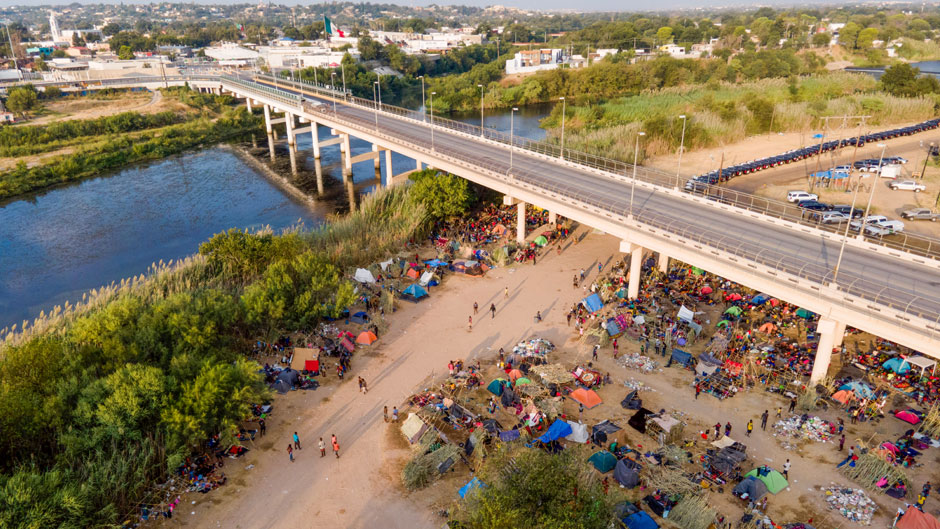Both Alejandro Portes and Alex Horenstein highlighted the perennial and increasing income disparities between the prosperous U.S. and Canada and the “Global South” countries of the Americas, where desperate conditions and lack of opportunity have created the most recent border crisis involving some 14,000 immigrants, most of whom are Haitians tracking an unprecedented secondary migration up from South and Central America.
Portes, a University of Miami law professor and Distinguished Scholar in the College of Arts and Sciences, further acknowledged that this newest episode is fueled by a calamitous driver: the collapse of governments in Haiti and Venezuela and with Honduras and Guatemala near to failing.
“Relative deprivation—the growing gap in life chances and job market opportunities between the rich countries and those of the global south—has increased and is one major force driving the crisis,” said Portes, who added that social media has exacerbated misinformation about U.S. immigration policy.
The second factor—the implosion of national states—is more immediate and triggering the current crisis, he said.

“Several countries in the hemisphere are essentially nonfunctional governments that are not capable of attending to the needs of their populations or providing opportunities for organized labor markets,” said Portes, noting that Venezuela is the largest and that one-fourth of that country’s previous population has left seeking refuge in other Andean countries “unwilling and not very welcoming recipients of the exodus.
Haiti is another imploded, failed state. “Following the earthquake in 2010 and a lot of other natural catastrophes, it’s not surprising that many people there escape and try to leave their country any way they can,” the immigration scholar said.
Most of the estimated 14,000 immigrants who camped near Del Rio, Texas, were Haitians who were granted humanitarian visas to leave Haiti and resettle in Brazil and Chile. Yet bias and lack of opportunities there prompted them to make their way up to the U.S./Mexican border in hopes of entering, according to Portes.
He suggested that given the relatively low numbers, the U.S., with some help from regional nongovernment organizations (NGOs), would be able to effectively manage the situation—were it not for the fact that the previous U.S. administration eviscerated the Office of Refugee Resettlement, the very government agency that is meant to handle such a scenario and had done so previously by accommodating refugees from Southeast Asia and Cuba.
“This secondary migration is unprecedented and poses a great dilemma for the present administration—it doesn’t want to appear racist, but, on the other hand, this is not something that can be allowed,” Portes pointed out.

Horenstein, a Latin American economic specialist and associate professor at the University of Miami Patti and Allan Herbert Business School, indicated that the pandemic and recent natural disasters have worsened an already dire situation.
“Crisis has hit many countries in the region, and people will always try to look for a better life for themselves and their families—the U.S. is the promised land in that regard,” he said, pointing out that the US/Mexico border delineates one of the highest income differences in the world.
He added that even better performing countries than Haiti and Venezuela, such as Mexico, are in difficult economic situations that have been exacerbated by the pandemic.
Horenstein suggested that the U.S. could reduce trade barriers and open its markets, thereby generating jobs that would diminish the impetus of people to leave.
“Leaving your family and friends, your customs and culture to become illegal and a target of persecution in another country—no one wants to do that,” he said. “If we pay more attention to Latin American countries and increase our efforts to help them find the path to prosperity as we have done in Europe or East-Asia, we might help reduce the illegal immigration flow while we create a bigger market for our own goods. Helping Latin America to unlock its economic potential is a win-win scenario.”
While the economic situation is in some ways unavoidable because of the income disparities, both specialists highlighted the political aspect as a root cause of the crisis.
“For many people, immigrants are a scapegoat, and it’s easy for politicians to blame a group that is precarious and can’t defend themselves,” Horenstein explained. “And they can’t vote, so what’s the harm of blaming them?”
This political scapegoating ignores the positive impact of immigration and precludes the possibility of remedying the crisis, according to Portes.
“There are 12 million undocumented immigrants already in the U.S.—12 million living in the shadows without any possible path to resolve their status—and every attempt to bring about some process of regularization has been blocked in Congress by the far-right wing of the Republican Party over the past several administrations, including that of George Bush,” he pointed out.
He said several positive steps the U.S. have taken in the past decade include reopening the H-2 visa—formerly mostly for West Indian workers for the Florida sugar cane harvest and similar to the Bracero program which operated from 1942-1964 for Mexicans—and that grants temporary visas for agricultural and non-agricultural laborers.
“Basically, without much fuss, it has resolved the problem of massive Mexican undocumented immigration, legally allowing half-a-million workers annually into the country,” Portes said.
He noted, too, the H-1B visa program for highly qualified personnel—engineers, math teachers, doctors, nurses, and others. Nearly half a million workers qualify annually, mostly from India, and fill an important void in the U.S. economy, according to Portes.
“These two legs of the immigration system to the U.S. have been put together fairly well and are working more or less,” he concluded.
“Immigration is on balance highly positive to the American economy,” Portes said. “You can see this in these temporary visa programs for both professionals and manual workers that are bringing in over one million people because they are needed by the U.S. labor market,” he added.
“And the other positive contribution of immigration is to prevent the implosion of the population—most of the growth in U.S. population in the last 20 years has been due to immigrants and their children,” Portes continued. “If the U.S. doesn’t want to follow Japan into demographic implosion, it might as well keep a relatively open system of immigration, which has been a good thing throughout the history of the nation and continues to be at present.”

